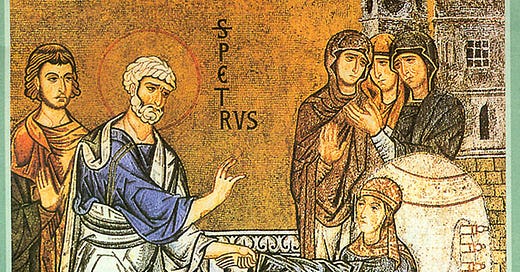Tabitha is Risen Indeed?!
Miracles are not metaphysical exceptions; they are historical promises.
Miracles reveal something of God’s nature.
Acts 9:36-43
In the Book of Acts, after Philip baptizes a eunuch bound for Ethiopia and just after the Risen Jesus commandeers Saul and bequeaths him a new name, the Spirit-emboldened Peter does what only God can do. Arriving in Joppa, Peter raises a dead disciple to new life. She was— is— named Tabitha. The passage recalls the urgent S.O.S. the sisters of Lazarus had sent to the LORD, “Since Lydda was near Joppa, the disciples, who heard that Peter was there, sent two men to him with the request, "Please come to us without delay." Washed and laid to rest in an upper room, a group of widows lead Peter to Tabitha’s corpse. Peter ushers them all outside.
Then Luke reports:
“Peter knelt down and prayed. He turned to the body and said, "Tabitha, get up." Then she opened her eyes, and seeing Peter, she sat up. He gave her his hand and helped her up. Then calling the saints and widows, he showed her to be alive.”
Tabitha is risen indeed!?
The challenge posed by the gospel is not simply that the Resurrection of Christ contradicts our Humean view of the world, it is also that Easter unleashes a torrent of miracle-making. Peter not only resurrects Tabitha, he heals a lame man. Paul makes a cripple whole and restores to life a young man named “Lucky” whom Paul literally bored to death. “By the hands of the apostles,” Luke notes dryly, “were many signs and wonders wrought among the people.”
The problem of miracles just is the problem posed by the gospel.
Or is it?
Keep reading with a 7-day free trial
Subscribe to Tamed Cynic to keep reading this post and get 7 days of free access to the full post archives.




